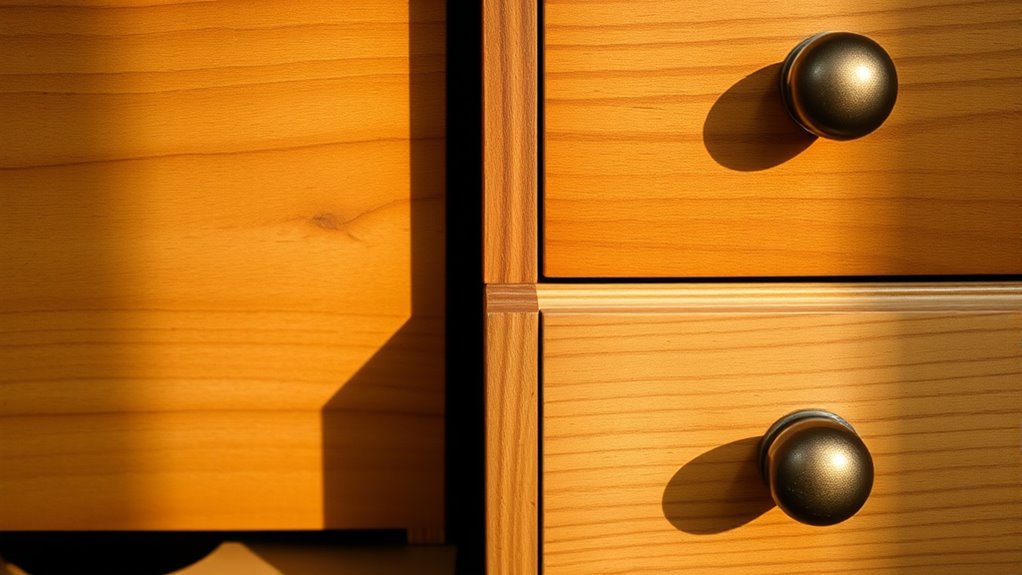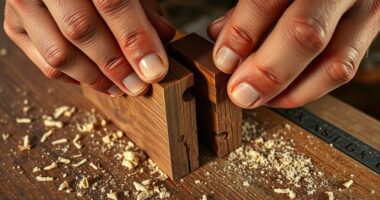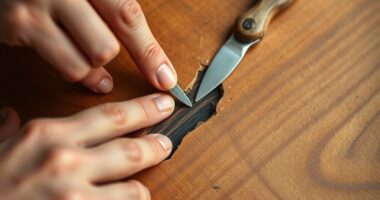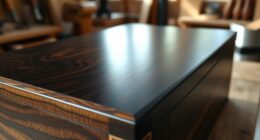To diagnose sticking drawers caused by racking or humidity, start by inspecting how your drawer fits within the cabinet—look for skewness or misalignment. Check for warped or swollen wood, which indicates moisture issues. Also, examine hinges for looseness or misadjustment. If you notice swelling or gaps, improving environmental conditions or adjusting hinges can help. Keep going for more tips on how to fix these common causes and restore smooth drawer operation.
Key Takeaways
- Inspect the drawer and cabinet for skewness or uneven gaps to identify racking issues.
- Check hinges for looseness or misalignment, and tighten or adjust as needed.
- Examine tracks and runners for debris, dirt, or sticky buildup, then clean and lubricate.
- Assess humidity levels; use dehumidifiers or humidifiers to stabilize moisture and prevent wood swelling.
- Consider sanding or planing swollen areas if excess moisture has caused significant warping.

Have you ever opened a drawer only to find it stuck or difficult to slide open? It’s frustrating when your furniture doesn’t move smoothly, especially if you rely on these drawers daily. Often, the problem stems from racking or humidity issues that cause the drawer or its tracks to warp or swell. To fix this, start by inspecting how the drawer fits within its frame. If it’s skewed or uneven, racking could be the culprit. Racking occurs when the drawer or the cabinet becomes misaligned, often due to shifting or warping over time. In some cases, it’s a simple matter of realigning the drawer or adjusting the hinges on the cabinet doors that impact the drawer’s movement.
One effective way to improve drawer operation is through drawer lubrication. Over time, the tracks and runners can accumulate dust, dirt, or dried-up lubricant, which increases friction. Applying a suitable lubricant, like a silicone spray or a wax-based product, can dramatically reduce resistance. You should remove the drawer from its frame to access the runners and lightly spray or apply the lubricant along the rails. Be careful not to overdo it—just enough to make the drawer glide smoothly. This simple step can resolve sticking caused by old, sticky lubricants or debris buildup.
In addition to drawer lubrication, hinge adjustment plays a critical role in ensuring smooth operation. Many drawers are connected to cabinet hinges, and if these hinges are loose or misaligned, the drawer may not sit properly in its frame. Check the hinges and tighten any loose screws. If the hinges are adjustable, tweak them slightly to ensure the door and drawer align perfectly within the cabinet. Proper hinge adjustment can prevent unnecessary rubbing or scraping that causes sticking. When hinges are correctly aligned, the drawer’s path becomes more direct, reducing friction and preventing it from catching.
Humidity is another factor that can cause drawers to stick. Excess moisture causes wood to swell, which can push against the drawer sides or tracks, leading to resistance. Conversely, dry air can cause wood to shrink, creating gaps that make the drawer feel loose or unstable. If humidity is an issue, consider using a dehumidifier or keeping a humidifier in the room to stabilize moisture levels. Sometimes, simply giving the drawer a gentle sanding or planing along the sides can help if swelling is severe. Additionally, understanding the impact of automation in maintenance routines can help prevent humidity-related issues by using smart environmental controls.
Frequently Asked Questions
Can Humidity Damage the Drawer Slides Over Time?
Yes, humidity can damage drawer slides over time. When moisture absorption occurs, it causes wood expansion, which can put pressure on the slides and lead to sticking or misalignment. Excess humidity can also cause metal components to rust or corrode, further impairing their function. To prevent this, keep your environment dry and maintain stable humidity levels, helping your drawer slides stay smooth and functional for years.
What Materials Resist Sticking Better in Humid Environments?
You might think metal or plastic would be the best, but ironically, moisture-resistant materials like sealed composites or treated woods actually resist sticking better in humid environments. These materials often have special wood treatments that prevent moisture absorption, reducing swelling and sticking. So, when humidity rises, your drawers stay smooth and functional, thanks to materials designed to shrug off moisture rather than absorb it like untreated wood or porous plastics.
How Do I Prevent Drawers From Sticking During Seasonal Humidity Changes?
To prevent drawers from sticking during seasonal humidity changes, you should regularly apply drawer lubrication with a suitable wax or silicone spray to keep the slides smooth. Additionally, control humidity levels in your home by using dehumidifiers or air conditioners, especially during damp seasons. These steps help minimize wood swelling and contraction, reducing sticking. Keep an eye on the environment and maintain consistent humidity to make certain your drawers open and close effortlessly year-round.
Are There Eco-Friendly Solutions to Fix Sticking Drawers?
Yes, you can fix sticking drawers with eco-friendly solutions. Use biodegradable lubricants like beeswax or plant-based oils to reduce friction, and apply eco-friendly adhesives if parts need reinforcement. These options are safe for the environment and effective at preventing sticking caused by humidity changes. Regular maintenance with natural lubricants can keep your drawers sliding smoothly without harming your home or the planet.
How Long Does It Typically Take to Repair Racking Issues?
Imagine a smooth, gliding drawer, perfectly aligned like a well-tuned instrument. Repairing racking issues usually takes a few hours, depending on the problem’s complexity. You’ll start by applying drawer lubrication to ease movement and adjusting hinges to realign the drawer front. With patience, you can have your drawers functioning smoothly in a short time, restoring harmony to your space.
Conclusion
By understanding the causes of sticking drawers, you can take simple steps to fix racking and humidity issues before they worsen. Regular maintenance and proper humidity control can keep your drawers sliding smoothly and prevent costly repairs down the line. Isn’t it worth investing a little effort now to avoid bigger headaches later? Taking care of your furniture not only preserves its beauty but also guarantees it remains functional and reliable for years to come.









